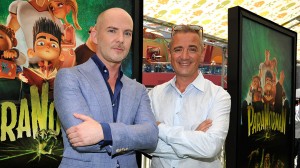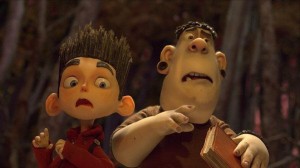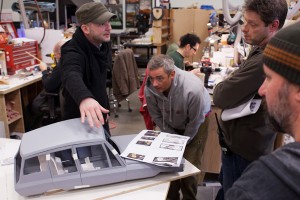 Chris Butler & Sam Fell are the co-directors of Laika Animation’s latest stop-motion animation film “ParaNorman”. The film is the first stop-motion film to utilize a 3D color printer to create replacement faces for its puppets and breaks all the boundaries which past stop-motion films have faced. Media Mikes had a chance to chat with the directors about working in the horror genre and blending it with stop-motion animation.
Chris Butler & Sam Fell are the co-directors of Laika Animation’s latest stop-motion animation film “ParaNorman”. The film is the first stop-motion film to utilize a 3D color printer to create replacement faces for its puppets and breaks all the boundaries which past stop-motion films have faced. Media Mikes had a chance to chat with the directors about working in the horror genre and blending it with stop-motion animation.
Mike Gencarelli: I am a big stop-motion fan but I see a trend with “The Nightmare Before Christmas”, Coraline” and “ParaNorman” all tend to have creepy aspects, why and do you you feel this aspect relates to stop motion?
Chris Butler: I think is the tradition of the medium. If you trace it back to its early days, in the 1890’s the very first efforts in stop-motion were creepy. “The Dancing Skeleton” was one of the first back in 1897. I think what it comes down to is they feature inanimate objects moving on their own accord, which in itself is something like black magic going on there. If you look at the pioneers of this medium, there was a certain creepiness to them. There has always been that slightly unsettling side of it. I believe it is entirely to do with it being real objects moving. When Tim Burton comes along and re-invents with with “The Nightmare Before Christmas”, he is playing on that and having fun with that slightly dark sense of humor. I don’t think it should be the limitation of the medium by any means. “ParaNorman” is kind of spooky but I think there shouldn’t be any real limits to the kind of stories you can tell with stop-motion.
MG: This is the first stop-motion film to utilize a 3D color printer to create replacement faces for its puppets, tell us about about that decision?
Sam Fell: Obviously these things aren’t designed for stop-motion animation. You are always taking a chance. We wanted to do something different on this film. They got a color printer in the studio and we did some experiments with it initially with the character Neil, who is covered in freckles. When we saw it on the tested it big screen it just looked so promising. It was one of those spine-tingling moments, when you see something you’ve never seen before. We didn’t know if it was going to work on all the characters or if it would literally last over a two year production. We took a risk and went for it but it really turned out so well. When you see how the light fall on those faces or comes through them. I think the characters look less like dolls and are even more tangible and believable.
with the character Neil, who is covered in freckles. When we saw it on the tested it big screen it just looked so promising. It was one of those spine-tingling moments, when you see something you’ve never seen before. We didn’t know if it was going to work on all the characters or if it would literally last over a two year production. We took a risk and went for it but it really turned out so well. When you see how the light fall on those faces or comes through them. I think the characters look less like dolls and are even more tangible and believable.
MG: I read that Norman alone has about 8,000 faces, how does that compare from other stop-motion films?
SF: I think with the numbers of faces, it has increased exponentially. I think Norman had a possible 1.5 million expressions at hand. We would never even use all of them since I don’t even think the human face can use that many expression. But that was at our finger tips. So pretty much whatever we wanted to do with this character we were able to do. It was really freeing because in the past stop-motion has had it limitations. There was replacement heads as far back as “The Nightmare Before Christmas” but they had to be hand-sculpted, so they were limited. Pretty much every limitation has been blown up on this movie. The boundaries in place of previous stop-motion movies, we broke them all. That was how we felt going into this. We thought let’s push this as far as we can and see what we can achieve. Everything we tried to do…it worked.
MG: The film is animated for a younger audience but is quite scary for some kids, how can you reflect?
SF: I think we wanted to make a family movie more than a kids movie. Something aimed at the teens or actually “tweens”. It is about an 11 year old boy and reflects their lives on screen. We wanted laughs, as well as scares and in a way it is like designing a roller coaster ride. We actually think that kids like scares. It is firstly entertaining and it also adds in a dramatic story. The hero, in this case a kid, has real challenges. You take them through it and show the darkness can be defeated. I think it makes for a great ride. We didn’t want to wimp out on the scares. We may loose the toddlers or the preschoolers but that is the risk you take. It is very hard to make a film for everybody…without being bland.
 CB: We were specifically referencing an era of movie making that I think was a little braver. The movie that I grew up watching like “The Goonies” and “Ghostbusters”. They weren’t afraid to have scares and show an imperfect world. But they did it with humor and style. I miss those movies and I feel that they are also sorely missed by many people. So it was nice to play in that era again. Even though it was a contemporary movie, it was very much referenced by the films of the 80’s.
CB: We were specifically referencing an era of movie making that I think was a little braver. The movie that I grew up watching like “The Goonies” and “Ghostbusters”. They weren’t afraid to have scares and show an imperfect world. But they did it with humor and style. I miss those movies and I feel that they are also sorely missed by many people. So it was nice to play in that era again. Even though it was a contemporary movie, it was very much referenced by the films of the 80’s.
MG: I loved the Easter eggs for horror fans like the hockey mask and ringtone, any other hidden gems?
CB: The movie is so dripped with references that I don’t even known where to start. It is not just stuff that was in the script. I wrote in the bar in touch is called the Bargento, in reference to the old Italian movies. The name of Neil’s dead dog is Bub, which is the name of the tamed zombie in “Day of the Dead”. Most of the characters surnames are either horror movie directors or writers, even if they do not appear in the movie. On top of that we have a whole crew of movie fanatics, who were responsible for making the props and locations. They stick all kinds of stuff in there as well. It is difficult to even pin-point how much there is actually in there. Sam’s name even ended up on the old tramps underpants [laughs].
SF: I didn’t ask for that by the way [laughs].
Related Content
- Interview with “Survivors Guide to Prison” filmmaker Matthew Cooke
- Ryan Reynolds talks about his latest film “Self/Less”
- Al Sapienza talks about roles in “Taken 3” and “Godzilla”
- Jai Courtney and Joel Edgerton talk about their new film “Felony”
- Jason Momoa talks about his latest film “Road to Paloma”
